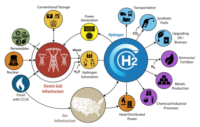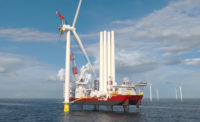To spur deployment of hydrogen as a cleaner replacement fuel for natural gas and diesel in hard-to-decarbonize industrial and transportation sectors, the new federal infrastructure law has earmarked $10 billion for its deployment—including $8 billion to create at least four U.S. “hydrogen hubs.”
The U.S. Energy Dept. now is moving quickly to launch the program’s “roadmap” this summer and demonstration projects soon after—as states, utilities, politicians, firms and others line up to win federal dollars for local projects underway or planned.
Regional hubs are envisioned as a network of clean-hydrogen producers, with customers and infrastructure to connect them. The goal is to decarbonize major industrial sectors dependent on natural gas. The Biden administration is pushing clean hydrogen basic research, demonstration projects and “ecosystem” development, said Jesse Adams, a DOE manager who leads the agency’s hydrogen hub effort.
The spending law calls for four hubs, but “we’re aiming for more, like six to ten, to ultimately get us closer to the goal of a national hydrogen network,” he said. DOE launched H2 Matchmaker, an interactive map tool to help hydrogen users and suppliers connect.
What Makes a Hub?
The Great Plains Institute, a Minneapolis nonpartisan think tank, identified 14 potential sites for hydrogen and carbon management hubs in U.S. regions (see map above), although these “are by no means exclusive,” it says.
“Hydrogen is a powerful decarbonization solution for multiple sectors and numerous end uses that are difficult to electrify, such as industrial process heat, heavy trucking, iron and steel production and marine shipping,” said Dane McFarlane, institute director of research.
Each DOE hub will be chosen based on a mix of criteria. At least one must use fossil fuels to produce hydrogen, known as "blue hydrogen," with others sourcing renewable energy and nuclear power for cleaner “green” hydrogen. Key selection factors also include a concentration of industrial emitters and high fossil fuel use; plants that qualify for carbon-capture 45Q tax credits; hydrogen and ammonia production; large geologic formations for hydrogen or CO2 storage; and existing infrastructure for hydrogen blending and for “low-impact” hydrogen and CO2 transport, says the institute.
Funding would be roughly $500 million to $1 billion per hub, with participants matching federal investment. DOE is reviewing 300 responses from its most recent request for input but has not said when its official RFP will be issued.
“There is quite a bit of enthusiasm in the market around hydrogen,” says Denise Brinley, vice president of strategic growth and client engagement at TRC Cos. “The $8 billion certainly has a lot to do with that, but there are hydrogen projects that are also being developed outside” of it.
She says TRC is advising fund seekers but declines to identify them or project details.
Regions Gear Up
San Francisco-based utility PG&E and engineer GHD are developing a 130-acre stand-alone demonstration pipeline that is set to study how different levels of hydrogen blended with natural gas perform in high-pressure transmission lines. It is a test loop to study a system that would first provide the blend to a northern California power plant, then expand to other end users to grow a hydrogen market in California, Jamie Randolph, PG&E principal hydrogen program manager, told ENR.
Eventually the hub will connect to other hubs in Oregon, Arizona and Southern California, she said. “The hubs are a community of stakeholders in the supply chain” that also will include hydrogen fueling stations in California, Randolph said. The project will test risk levels and mitigation in transporting hydrogen-blended fuel in natural gas pipelines to industrial customers, she said. Construction is expected to begin in 2023.
Southern California Gas is developing green hydrogen infrastructure around Los Angeles to build a hub there that would displace about 25% of the natural gas now delivered, the company said.
A Los Angeles city council committee approved a measure on May 5 for officials to submit a hub proposal to DOE. A May 16 California Senate hearing is set for a bill to create a clean hydrogen hub fund and require Gov. Gavin Newsom to appoint a state director.
New York, Connecticut, Massachusetts and New Jersey also inked a multi-state agreement with an eye toward becoming a DOE clean-hydrogen hub. Latham, N.Y.-based hydrogen fuel cell developer Plug Power Inc. is a partner in the New York-led push and has hired the CB&I unit of McDermott International to design and build two 500,000-gallon, double-wall hydrogen spheres for its hydrogen plant in Genesee County. Plug Power expects to produce 45 metric tons of green hydrogen per day using proton exchange membrane electrolyzers.
Hubs Gain Backers
West Virginia also submitted a hub proposal in March, noting its dense natural gas and pipeline network, with backers including its two high-profile U.S. senators, Joe Manchin and Shelley Moore Capito, and other top state politicians.
But the push would compete with a public-private proposal from a new northern Appalachian group that would leverage resources from Ohio and Pennsylvania as well as West Virginia. Also, Louisiana, Oklahoma and Arkansas launched the HALO hub coalition, which will repurpose depleted oil and gas reservoirs and use geological formations for hydrogen storage and carbon capture.
Developers Bakken Energy and Mitsubishi Power will seek funds for an estimated $2-billion hub at a former synfuels plant in North Dakota. It would operate in early 2027 as one of North America’s largest such facilities, set to produce 348,000 metric tons of hydrogen per year.
The project aims to recover 95% of its emissions, developers claim, and a partnership with tribes could help it meet DOE environmental justice rules. A Texas nonprofit aims to develop a Gulf Coast hydrogen hub with a major overseas export center in Corpus Christi, S&P Global said May 10. Other states eyeing hubs independently include Washington, Arizona, Kentucky, Illinois and Nebraska.
Bridget van Dorsten of energy research firm Wood Mackenzie says “blue” hydrogen from fossil fuels is an imperfect climate solution, “but in the U.S., whose politics are influenced by the world’s largest oil and gas industry, [it] might be the easiest path to getting carbon reductions.”
Aiming for Green
Utah, Colorado, New Mexico and Wyoming are co-developing a hub with its “green” status linked to work starting on a Utah project touted as the world’s largest industrial facility to convert more than 220 MW of water and renewable energy daily to 100 metric tons of green hydrogen to be stored in caverns.
Developers Mitsubishi and Magnum Development hired WSP Global Inc. for cavern EPC services and Black & Veatch for facilities. The project’s total cost was not updated publicly from a $1-billion estimate in 2019, but it just won in April a conditional $504-million DOE loan. Black & Veatch incoming CEO Mario Azar terms the project ”a transformative event ... in decarbonization at scale.”





